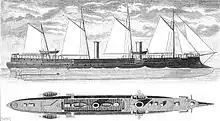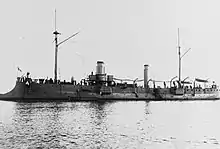French cruiser Coëtlogon
Coëtlogon was a protected cruiser of the Forbin class built in the late 1880s and early 1890s for the French Navy; she was the last member of her class to be built. The Forbin-class cruisers were built as part of a construction program intended to provide scouts for the main battle fleet. They were based on the earlier unprotected cruiser Milan, with the addition of an armor deck to improve their usefulness in battle. They had a high top speed for the time, at around 20 knots (37 km/h; 23 mph), and they carried a main battery of four 138 mm (5.4 in) guns.
 Coëtlogon underway | |
| History | |
|---|---|
| Name: | Coëtlogon |
| Builder: | Ateliers et Chantiers de Saint-Nazaire Penhoët |
| Laid down: | 1887 |
| Launched: | 3 December 1888 |
| Completed: | August 1894 |
| Stricken: | 1906 |
| General characteristics | |
| Class and type: | Forbin-class protected cruiser |
| Displacement: | 1,901 long tons (1,932 t) |
| Length: | 95 m (311 ft 8 in) lwl |
| Beam: | 9 m (29 ft 6 in) |
| Draft: | 5.23 m (17 ft 2 in) |
| Installed power: |
|
| Propulsion: | |
| Speed: | 20 to 20.5 knots (37.0 to 38.0 km/h; 23.0 to 23.6 mph) |
| Complement: | 199 |
| Armament: |
|
| Armor: | Deck: 41 mm (1.6 in) |
Coëtlogon saw little activity, in part because problems with her propulsion system delayed her completion by three years; after a serious breakdown while on sea trials in 1891, the entire system had to be replaced. She was finally completed in 1895, when she joined the Northern Squadron, though she only served in the unit for two years. She saw no further active service, and she was struck from the naval register in 1906, thereafter being broken up.
Design

Beginning in 1879, the French Navy's Conseil des Travaux (Council of Works) had requested designs for small but fast cruisers of about 2,000 long tons (2,032 t) displacement that could be used as scouts for the main battle fleet. The unprotected cruiser Milan was the first of the type, which was developed into the Forbin-type of protected cruisers after the Conseil requested light armor protection for the ships.[1][2] The three Forbins, along with the three very similar Troude-class cruisers, were ordered by Admiral Théophile Aube, then the French Minister of Marine and an ardent supporter of the Jeune École doctrine.[3][4]
Coëtlogon was 95 m (311 ft 8 in) long at the waterline, with a beam of 9 m (29 ft 6 in) and a draft of 5.23 m (17 ft 2 in). She displaced 1,901 long tons (1,932 t). Her crew amounted to 199 officers and enlisted men. The ship's propulsion system consisted of a pair of compound steam engines driving two screw propellers. Steam was provided by six coal-burning fire-tube boilers that were ducted into two funnels. Her machinery was rated to produce 5,800 indicated horsepower (4,300 kW) for a top speed of 20 to 20.5 knots (37.0 to 38.0 km/h; 23.0 to 23.6 mph).[5]
The ship was armed with a main battery of four 138 mm (5.4 in) 30-caliber guns in individual pivot mounts, all in sponsons with two guns per broadside. For close-range defense against torpedo boats, she carried three 47 mm (1.9 in) 3-pounder Hotchkiss guns and four 37 mm (1.5 in) 1-pounder Hotchkiss revolver cannon. She was also armed with four 350 mm (14 in) torpedo tubes in her hull below the waterline, and she had provisions to carry up to 150 naval mines. Armor protection consisted of a curved armor deck that was 41 mm (1.6 in) thick, along with a cofferdam and thin anti-splinter deck covering the machinery spaces.[5]
Service history

Work began on Coëtlogon with her keel laying at the Ateliers et Chantiers de Saint-Nazaire Penhoët shipyard in 1887. She was launched on 3 December 1888 and was completed for sea trials in 1891,[5][6] but her propulsion system failed and had to be completely replaced. This delayed her entry into service by three years, as corrections had to be made repeatedly, even after the new system was installed. Trials conducted in March 1894 had to be stopped due to excessive friction in the engines, which caused so much vibration in the hull that the ship's compasses were not usable. She ran acceptable trials in June, where she reached a top speed of 20.4 knots (37.8 km/h; 23.5 mph) using forced draft, though was not ready for service until August.[5][7] She completed her initial sea trials in 1895; during the testing, she reached a maximum average speed of 20.6 knots (38.2 km/h; 23.7 mph).[8]
That year, she was assigned to the Northern Squadron, which was kept in commission for only four months per year. The unit at that time consisted of the coastal defense ship Furieux, the ironclads Requin, Victorieuse, and Suffren, the armored cruiser Latouche-Tréville, and the protected cruisers Jean Bart and Surcouf.[9] Coëtlogon took part in the annual fleet maneuvers that began on 1 July. The exercises took place in two phases, the first being a simulated amphibious assault in Quiberon Bay, and the second revolving around a blockade of Rochefort and Cherbourg. The maneuvers concluded on the afternoon of 23 July.[10]
She remained in the unit in 1896.[11] She took part in the maneuvers that year, which were conducted from 6 to 26 July in conjunction with the local defense forces of Brest, Rochefort, Cherbourg, and Lorient. The squadron was divided into three divisions for the maneuvers, and Coëtlogon was assigned to the 3rd Division along with the coastal defense ship Bouvines and the armored cruiser Dupuy de Lôme, which represented the enemy squadron.[12] By January 1901, she and both of her sister ships had been reduced to the reserve fleet.[13] The ship had a short service life and was struck from the naval register in 1906;[5] she was subsequently sold to ship breakers for scrap.[6]
Notes
- Ropp, pp. 129–130.
- Gardiner, p. 320.
- Ropp, p. 172.
- Gardiner, p. 310.
- Gardiner, p. 309.
- Gardiner & Gray, p. 193.
- Dorn & Drake, p. 50.
- Brassey 1895a, p. 24.
- Brassey 1895b, p. 50.
- Barry, pp. 186–190.
- Brassey 1896, p. 62.
- Thursfield, p. 167.
- Jordan & Caresse, p. 219.
References
- Barry, E. B. (July 1896). "Naval Manoeuvres of 1895". Notes on the Year's Naval Progress. Washington, D.C.: United States Office of Naval Intelligence. XV: 163–214. OCLC 727366607.
- Brassey, Thomas A. (1895a). "Ships Building In France". The Naval Annual. Portsmouth: J. Griffin & Co.: 19–28. OCLC 496786828.
- Brassey, Thomas A. (1895b). "Chapter III: Relative Strength". The Naval Annual. Portsmouth: J. Griffin & Co.: 49–59. OCLC 496786828.
- Brassey, Thomas A. (1896). "Chapter III: Relative Strength". The Naval Annual. Portsmouth: J. Griffin & Co.: 61–71. OCLC 496786828.
- Dorn, E. J. & Drake, J. C. (July 1894). "Notes on Ships and Torpedo Boats". Notes on the Year's Naval Progress. Washington, D.C.: United States Office of Naval Intelligence. XIII: 3–78. OCLC 727366607.
- Gardiner, Robert, ed. (1979). Conway's All the World's Fighting Ships 1860–1905. London: Conway Maritime Press. ISBN 978-0-85177-133-5.
- Gardiner, Robert & Gray, Randal, eds. (1985). Conway's All the World's Fighting Ships: 1906–1921. Annapolis: Naval Institute Press. ISBN 978-0-87021-907-8.
- Jordan, John & Caresse, Philippe (2017). French Battleships of World War One. Annapolis: Naval Institute Press. ISBN 978-1-59114-639-1.
- Ropp, Theodore (1987). Roberts, Stephen S. (ed.). The Development of a Modern Navy: French Naval Policy, 1871–1904. Annapolis: Naval Institute Press. ISBN 978-0-87021-141-6.
- Thursfield, J. R. (1897). Brassey, Thomas A. (ed.). "Naval Maneouvres in 1896". The Naval Annual. Portsmouth: J. Griffin & Co.: 140–188. OCLC 496786828.